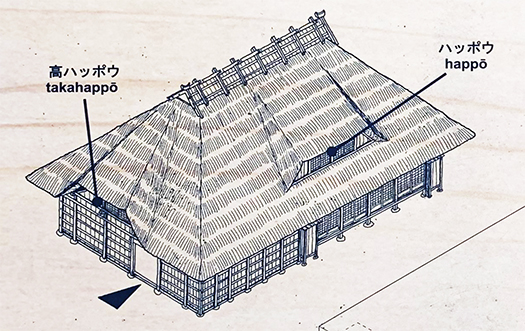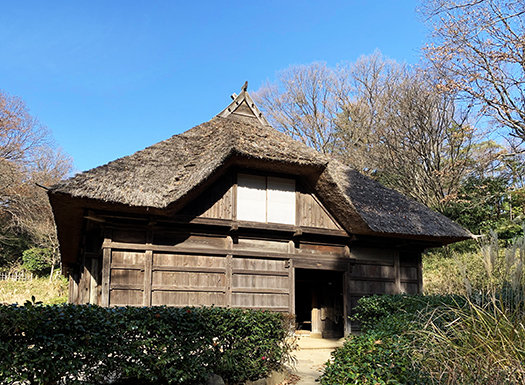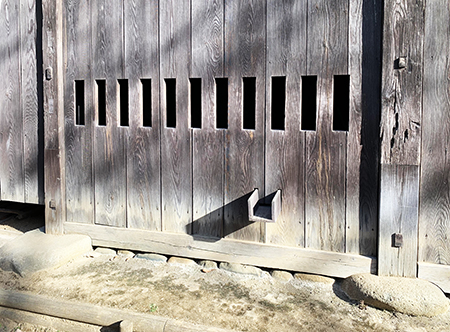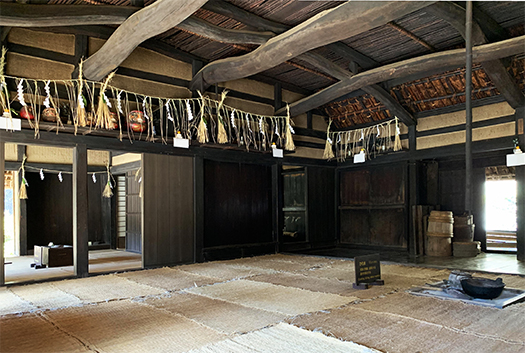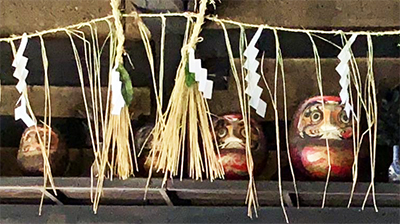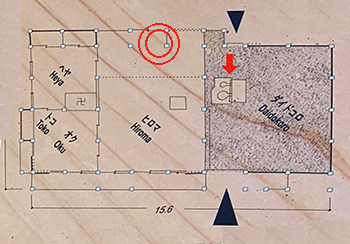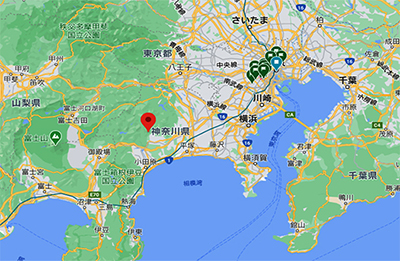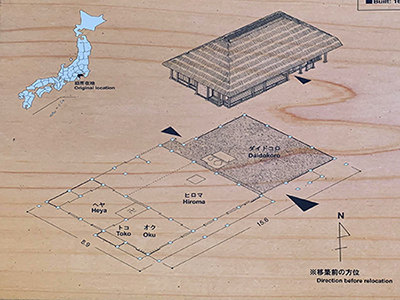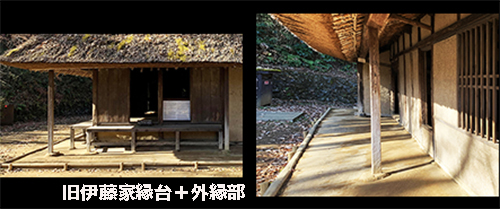
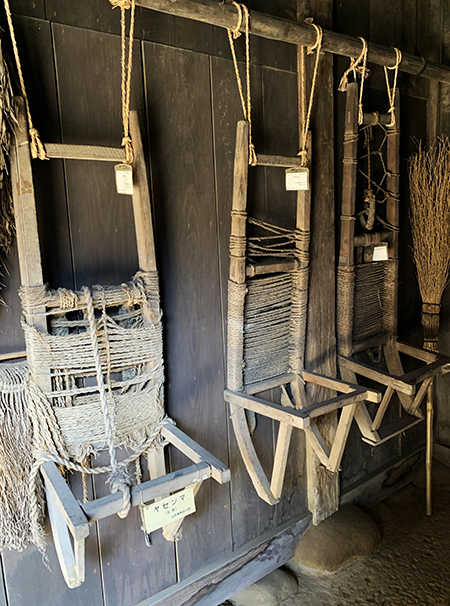
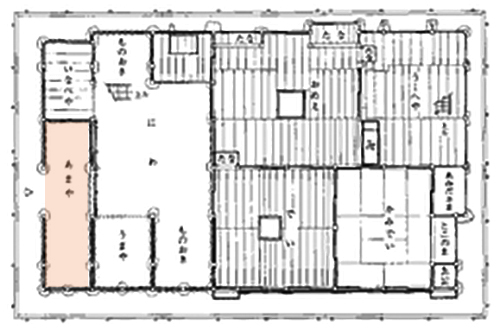
すぐ上の図面で彩色した部分が「風除室」で入口すぐの場所。
「あまや」というコトバが宛てられているけれど、
漢字を表記すれば「雨屋」とでもなるのだろうか。
たしかに「蓑」が下げられていたりするので、表現が似合いそう。
風除室というのは、積雪寒冷地域では生活上需要の大きい場所なので、
現代住宅でも多く採用されている。その古民家での収納の様子。
暮らし、労働に直結する道具類が収められていて人間の息づかいを感じる。
冬になると3mを越す積雪が集落を襲う。春まで融けることのない「根雪」は
11月初旬に降り、翌年5月を待たなければ雪から解放されなかった。
最低気温も零下3度くらいまで下がり小さい子どもは泣きながら学校に通ったと。
大切なわが家を雪から守る対策が講じられました。
建物の軒から下を守る「雪囲い」や、家の周囲に巡らされた「ホリ」・ため池は、
浄水であると同時に消雪の役割も果たしたとされます。
冬中、暮らしに必要な物資の運搬にはソリやタケノマなどを使用して、
人間もカンジキを履いて足場の悪い雪道往来を工夫していました。
タケノマというのは写真の竹を編んだような面状のもの。
冬期間雪の山中から薪を運搬する際などに重宝して利用されたという。
背中にはヤセンマという呼び名の背負子でも、物資を運んだ。
長い冬を乗り切るために食料の保存方法も工夫された。
床下には「モロ」貯蔵室が作られ、冬中雪を積んだ天然の「冷蔵庫」も作って
野菜などを保存させた。長期保存の漬物が作られ続けたのは自然でしょう。
雪を融かすためにため池を家の周りに作ったのは
北海道ではちょっと考えにくい工夫と思われる。
現代でも日本海側の東北・北陸地域では消雪のため道路に水が流される。
その知恵はこれら地域では一般的のようです。
たぶん北海道でも移住初期にはそういう試行もあったかも知れないけれど、
マイナス10度、20度さらには30度という低温の風土で
この雪国ニッポンの知恵はまったく通用しなかっただっただろう。
巨大なスケートリンクや氷柱が住宅周辺にできることになる。
雪囲いが装置されるからか、案外外壁の板張りはラフな仕上げ。
この住居ではかなり「すき間」が目立っているけれど、
積雪という天然の「断熱層」のなかで、気温低下がそれほどでない場合、
湿気が籠もるということもあったのではないかと想像できる。
半年の「耐え忍ぶ冬」という概念が身に迫ってくるように感じる。
こういう長きにわたった民族体験は、DNAに辛抱強い性格を涵養するだろう。
一方、翻って北海道のドライな雪質のひたすら寒冷な冬は
日本人にどういう心象を形成し、やがてDNA化していくことになるのか、
北海道人としてわがことながら、興味を強く持っている。
なにか、すでにして東北地域・北陸地域の「地域性格」とはすこし乖離が
生まれつつあるようにも思っております。・・・
English version⬇
[Working tools for the heavy snowfall “windbreak room” / Japanese good house ㉓-3]
The part colored in the drawing just above is the “windbreak room”, which is right next to the entrance.
Although the word “Amaya” is addressed,
If you write the kanji, will it be “Ameya”?
Certainly, “Mino” is lowered, so the expression seems to suit.
The windbreak room is a place where there is a great demand for daily life in snowy and cold regions, so
It is also widely used in modern homes. The state of storage in the old folk house.
It contains tools that are directly related to living and labor, and you can feel the breath of human beings.
In winter, more than 3m of snow hits the village. “Neyuki” that does not melt until spring
It got off in early November, and I had to wait for May of the following year before I was released from the snow.
It is said that the minimum temperature dropped to about 3 degrees below zero and small children went to school crying.
Measures have been taken to protect our precious home from snow.
The “snow fence” that protects the bottom from the eaves of the building and the pond called “Hori” that surrounds the house
It is said that it played a role of removing snow as well as purifying water.
During the winter, sleds and bamboo sledges are used to transport supplies necessary for daily life.
Humans also wore snowshoes to devise traffic on snowy roads with poor footing.
Even a backpack carrier named Yasenma carried supplies on his back.
Food preservation methods have also been devised to survive the long winter.
A storage room called “Moro” was created under the floor, and a natural “refrigerator” loaded with snow during the winter was also created.
I used to store vegetables. It is natural that pickles have been continuously made for long-term storage.
The reason why the pond was built around the house to melt the snow
It seems to be a little difficult to think about in Hokkaido.
Even today, in the Tohoku and Hokuriku regions on the Sea of Japan side, water is flowing on the roads to eliminate snow.
That wisdom seems to be common in these areas.
Perhaps even in Hokkaido, there may have been such an idea in the early days of emigration,
In a low temperature climate of -10 degrees, 20 degrees and even 30 degrees
I think it was the wisdom of “Snow Country Japan” that didn’t work at all.
Huge skating rinks and icicles will be created around the houses.
The boarding of the outer wall is unexpectedly rough, probably because the snow fence is installed.
There was a lot of “gap” in the restored house, but
If the temperature does not drop so much in the natural “insulation layer” of snow cover,
I can imagine that there was a case where the humidity was trapped.
It feels like the concept of “winter to endure” for half a year is approaching.
Such a long-standing ethnic experience will cultivate a patient personality in DNA.
On the other hand, in the cold winter of Hokkaido with dry snow.
What kind of image will be formed and will eventually become DNA?
As a Hokkaido citizen, I have a strong interest in it.
Something is already a little different from the “regional character” of the Tohoku and Hokuriku regions.
I also think that it is being born.・ ・ ・
Posted on 2月 20th, 2021 by 三木 奎吾
Filed under: 住宅マーケティング, 日本社会・文化研究 | No Comments »



